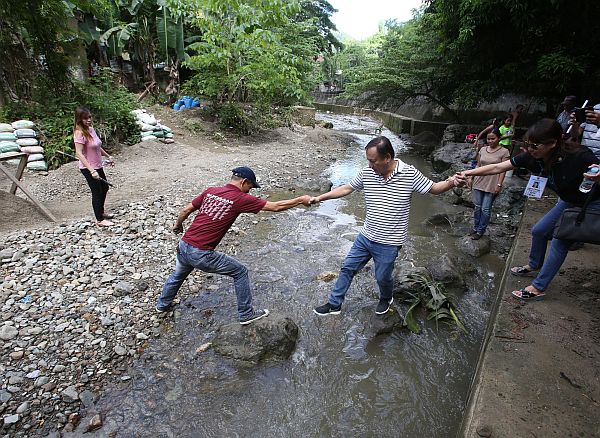
Cebu City Councilor Joy Augustus Young crosses the river on his way to the Sapangdaku Elementary School for an inspection of ongoing rehabilitation works on the school building.
.(CDN PHOTO/JUNJIE MENDOZA)
To do away with costly transportation expenses, parents want their children to hold classes at the old Sapangdaku Elementary School, which city hall ordered abandoned four years ago.
Nene Toreon, 35, said it is more practical for the Cebu City government to spend on the school’s rehabilitation instead of making parents spend on the transportation of their children if they are transferred to the Guadalupe Elementary School.
Toreon, a mother of six, said that her earnings from making hanging rice will never be enough for her children’s meals and transportation to school.
“I am agreeable to having the school because transferring our children to another school will be very costly,” Toreon said in Cebu.
Frenz Nicole Abella concurred with Toreon.
Councilor Joy Augustus Young, the deputy mayor for education, visited Barangay Sapangdaku on Wednesday for an ocular inspection of the old school building.
During his visit, he also announced the city’s plan to have the old school consisting of eight classrooms reopened in time for the opening of public school classes on June 5.
Young said city engineers have started clearing and repair of the old school building’s roof and ceiling, among others.
They will also transfer its main gate that is now located close to the Sapangdaku river to another location to ensure safety of school children especially when water level at the nearby river rises.
“Para sigurado lang, atong gibutangan og risk measures. One is ang entrance (To ensure safety of the students, we are adopting some safety measures.
One of them (is the transfer) of the entrance (to another area),” Young said.
The school that is built close to the Sapangdaku River was abandoned in 2013 following a series of flooding incidents which damaged some of its facilities.
Its premises including its classrooms would get flooded every time the river would overflow.
But Young said that only the around 240 Grades 4, 5 and 6 students will be allowed to use the old school building.
Grade 1, 2 and 3 pupils will continue to hold classes at their temporary classrooms built on the second and third floors of the Sapangdaku Barangay Hall.